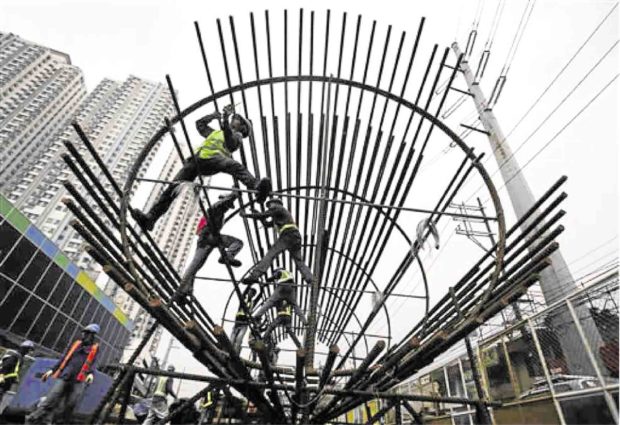MANILA, Philippines—By the end of President Ferdinand Marcos Jr.’s term, public infrastructure spending would have hit its highest share to the economy, at a record-high 6.3 percent of gross domestic product (GDP), according to his economic team’s medium-term plan.
The Cabinet-level Development Budget Coordination Committee (DBCC) last week set the annual infrastructure program for the next six years, as the Marcos administration wanted to sustain the Duterte administration’s ambitious “Build, Build, Build” program.
The new administration nonetheless sought a renewed focus on public-private partnership (PPP) projects, given the government’s narrower fiscal space wrought by the prolonged COVID-19 pandemic.
As a follow-through to the P1.12 trillion—or 5.8 percent of GDP—that the national government, local government units (LGUs) and state-run corporations spent on infrastructure last year, the DBCC plans to spend P1.19 trillion, or 5.5 percent of GDP this year.
For 2023, the DBCC had set total infrastructure spending at P1.28 trillion (5.4 percent of GDP); P1.39 trillion (5.4 percent of GDP) in 2024; P1.51 trillion (5.3 percent of GDP) in 2025; and P1.71 trillion (5.5 percent of GDP) in 2026.
By 2027, the amount to be disbursed on infrastructure will breach P2 trillion, equivalent to 5.8 percent of GDP.
In 2028, or the year Marcos ends his six-year term, the infrastructure program will reach P2.38 trillion, or 6.3 percent of GDP.
While Socioeconomic Planning Secretary Arsenio Balisacan last week said the administration preferred private proponents to bankroll solicited PPP projects, which formed part of the government’s infrastructure roadmaps, the National Economic and Development Authority (Neda) chief also said unsolicited pitches would still be accommodated as long as they complement the public investment plan.
The Duterte administration had shunned PPPs, especially unsolicited projects, as it did not want disadvantageous provisions like government guarantees, subsidies, and material adverse government action (Maga) clauses.
But the pipeline of big-ticket infrastructure projects under Build, Build, Build it left behind had 20 unsolicited PPP projects worth P1.5 trillion to be financed by tycoons’ deep pockets.
Balisacan also last week said that Neda under his watch “will ensure that comments on the revised IRR [implementing rules and regulations] of the amended BOT [Build-Operate-Transfer] law for PPPs are heard and carefully considered.”
Business groups have been jittery about the revised BOT IRR approved by ex-president Rodrigo Duterte’s economic team, which not only shielded the government from arbitration, but also provided “anti-market” definitions of contingent liabilities arising from PPP projects. Contingent liabilities included Maga clauses, force majeure, breach of government warranties, as well as failure to deliver contractual obligations.
Former Neda chief Karl Kendrick Chua had said the amended BOT IRR would protect Filipinos from contingent liabilities arising from PPP projects’ “high” return on investment (ROI), which private firms charge and the government shoulders, and ultimately paid for by consumers who use these infrastructure.
The DBCC had projected the contingent liability stock, or the aggregate amount wrought by PPP projects, to have risen to P456.2 billion in 2021 from the estimated P311.8 billion in 2020.
It was on top of the P60.4-billion “flow” of contingent liabilities or the amount which “may materialize within a specific interval of time taking into consideration a project’s risk factors” among 18 national PPP contracts signed between 2008 and 2020.


